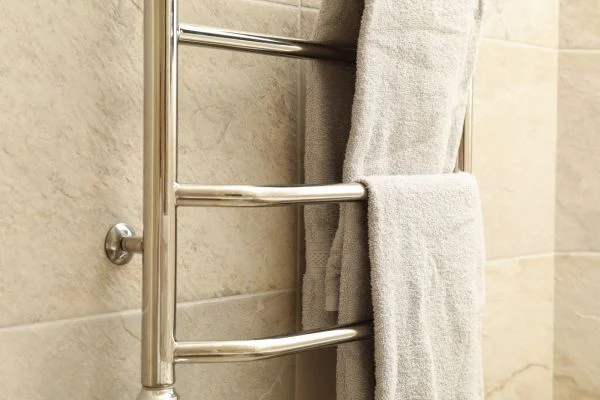Do you always think: Are heated towel rails expensive to Run? If yes, this article is your destiny. Heated towel rails provide warmth and convenience in your bathroom and add an element of luxury.
However, consider its energy efficiency and potential running costs before installing a heated towel rail. This article examines the factors that influence the running costs of heated towel rails and their overall energy efficiency.
Are Heated Towel Rails Expensive To Run | Let’s Find Out
Energy Efficiency of Heated Towel Rails:
Due to their localized heating function, heated towel rails are energy-efficient. Unlike central heating systems, heated towel rails reduce energy consumption by concentrating heat on a small area. Due to the rail’s construction and materials, towels dry quickly while consuming little energy.
Operating Modes:
With heated towel rails, users can adjust the heat output and energy consumption according to their needs. The modes are:
- Continuous heating: The towel rail maintains a constant temperature. Although this mode ensures towels are always warm and ready to use, it consumes more energy.
- Timer Control: This mode allows you to set specific operating schedules, ensuring the towel rail operates only when needed. By limiting the usage to specific times of the day, energy consumption can be significantly reduced.
- Thermostatic Control: Heated towel rails equipped with thermostatic controls regulate the temperature based on ambient conditions. Once the desired temperature is reached, the rail will adjust its heating output accordingly, minimizing energy wastage.
Power Source:
The power source the heated towel rail uses can affect its running costs. There are two main types:
- Electric: Electric heated towel rails operate independently from the central heating system and are powered directly from the mains electricity. While they may have higher running costs than central heating-connected models, they offer greater flexibility and control, allowing you to heat the towel rail as required.
- Central Heating: Towel rails connected to the central heating system using hot water circulated from the boiler. Since they rely on the overall operation of the central heating system, their running costs are typically lower. However, it’s important to note that they may have limited control options compared to electric models.
Insulation and Heat Retention:
The level of insulation and heat retention of the towel rail can impact its energy efficiency. Well-insulated towel rails can minimize heat loss and maintain the desired temperature more effectively, reducing the need for frequent heating cycles and optimizing energy consumption.
Also Read: Can A Heated Towel Rail Replace A Radiator?
Towel Rail Size and Usage Patterns:
The size of the towel rail and how it is used also play a role in determining running costs. More oversized towel rails with more bars will consume more energy to heat than smaller ones. Additionally, the frequency and duration of towel usage will affect the overall energy consumption.
Proper towel management, such as hanging towels efficiently and not leaving the rail on unnecessarily, can help reduce running costs.
Energy-Saving Features:
Many modern heated towel rails incorporate energy-saving features to enhance efficiency. These may include built-in timers, thermostats, and temperature control options, allowing you to customize the usage according to your preferences while minimizing energy waste.
Cost Comparison:
The running costs of heated towel rails can vary depending on factors such as energy rates in your region, usage patterns, and the efficiency of the specific model.
To better understand the potential running costs, you can calculate the electricity consumption using the wattage of the towel rail and the estimated usage hours.
Also Read: How Do Heated Towel Rails Work?
Is It Cheaper To Leave A Heated Towel Rail On?

The cost of leaving a heated towel rail on depends on many factors, including the energy efficiency of the rail, the duration of its use, and local electricity rates. When not in use, turning off the heated towel rail is more cost-effective.
Heat towel rails use electricity to generate heat and maintain a warm temperature. Continuously left on, they consume electricity, resulting in higher energy bills. The exact cost can vary depending on the rail power rating, duration, and electricity rates.
Consider the power rating of the heated towel rail (in watts) and your electricity rate (in kilowatt-hours). Kilowatt-hours (kWh) are calculated by multiplying the power rating by the number of hours the rail is on. Calculate the cost by multiplying the energy consumption by the electricity rate.
If you leave a heated towel rail on for 10 hours daily with a power rating of 200 watts (0.2 kW), you will consume 2 kWh (0.2 kW x 10 hours). The daily cost of leaving the rail on would be $0.30 (2 kWh x $0.15).
Consider using timer switches or programmable thermostats to control the operation of the heated towel rail to minimize costs. Energy-efficient models can also reduce electricity consumption and costs.
Also Read: Can Heated Towel Rails Catch Fire?
Bottom Line
So, Are Heated Towel Rails Expensive To Run? Heated towel rails offer practical benefits and luxury in the bathroom. While they consume energy, their localized heating function, energy-efficient features, and various operating modes help optimize energy consumption.
By selecting the right towel rail size, utilizing energy-saving features, and practicing efficient towel management, you can minimize running costs while enjoying the comfort and convenience of warm towels.
Ultimately, choosing an energy-efficient heated towel rail and considering your usage patterns will help balance comfort and cost-effectiveness in the long run.



